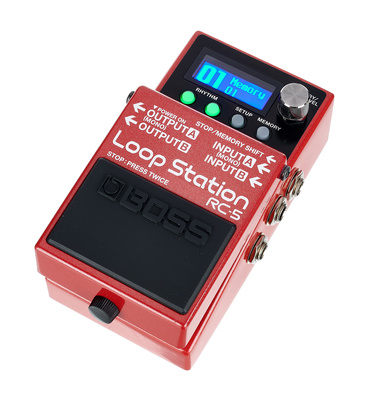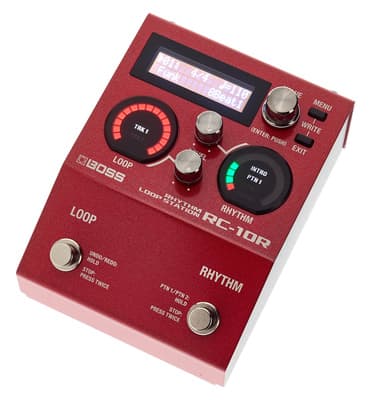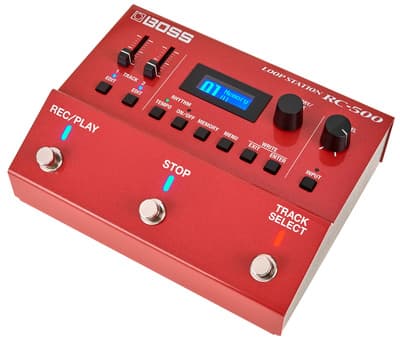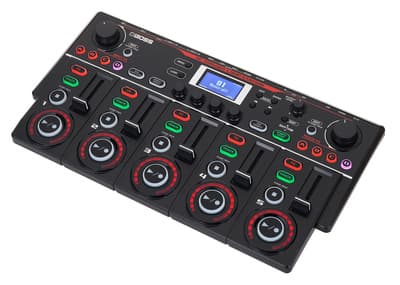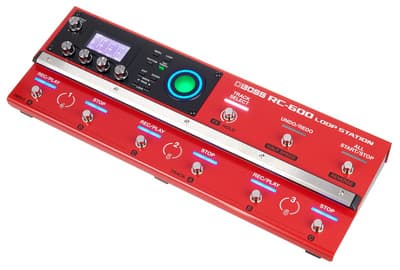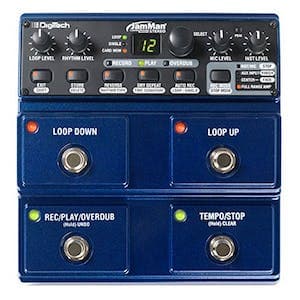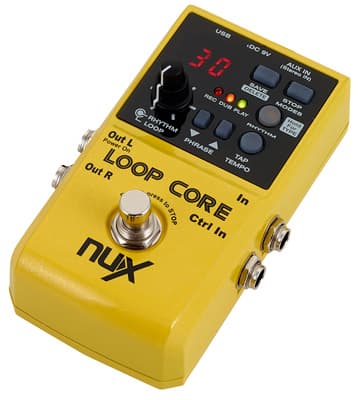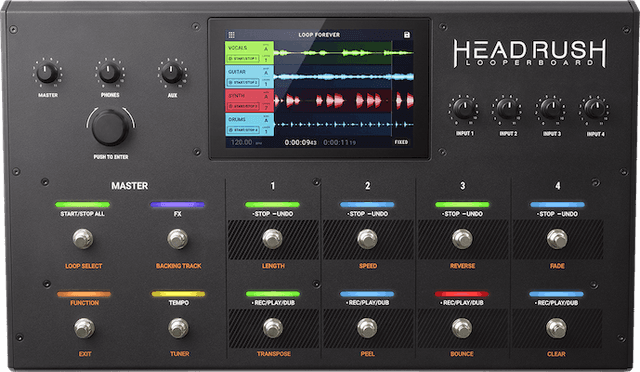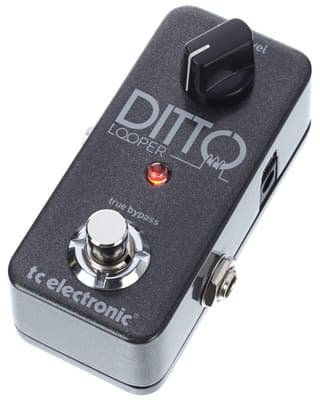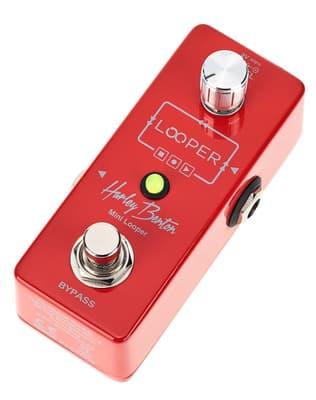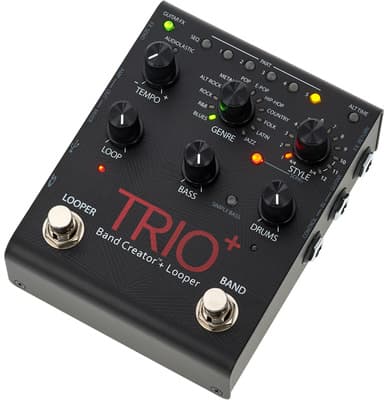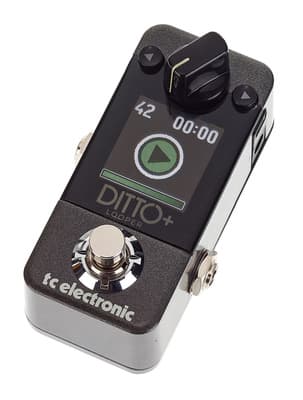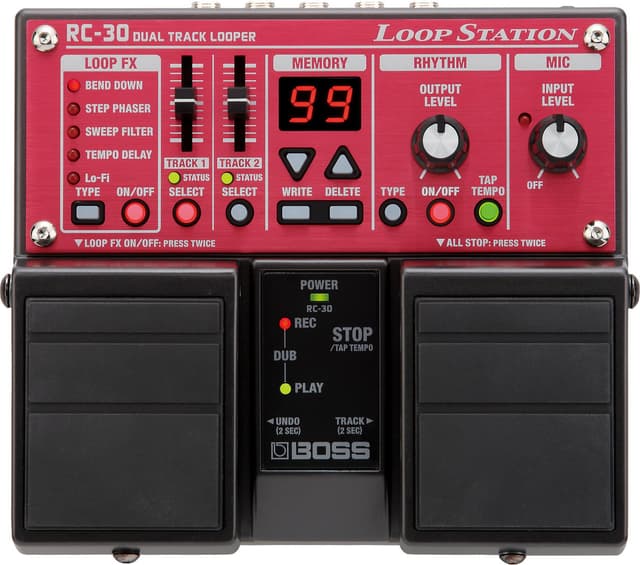Boss RC-5 Loop Station - Test & Review
Great Loop Station for Beginners with Drum Machine and MIDI Features
Since the release of the RC-5 at the end of 2020, Boss has expanded its Loop Station line-up with a successor to the Boss RC-3, which you can read about in our review of that model. What is the new Loop Station by Boss capable of and what exactly has changed compared to its predecessor? Find all the answers in the following review!
Features and Specifications
Like its predecessor, the RC-5 has a very compact and lightweight case and a mine design. It has exactly the same dimension as the RC-3 with 7.3 cm width and 12.9 cm depth, but with a height of 5.6 cm, the RC-5 is slightly smaller than the predecessor model. The weight has remained exactly the same at 450 grams and downright invites you to take the device along in your gig bag.
A striking new feature of the RC-5 is the larger LC display. To use it, there are four small buttons, a knob and, of course, the integrated foot switch. All in all, it gives a neater impression than the RC-3. And by the way, the display has a multicoloured backlight to always show you which mode the Loop Station is currently in.
Most other changes to the RC-3 are hidden underneath the case of the RC-5: While you have to work with a 16-bit signal processing in the RC-3, the RC-5 offers you contemporary and high-quality 32-bit audio. This practically means that even with numerous layers of overdubs, the sound is clear and there is no sign of muddy noises. With 99 slots the memory for phrases remained the same, but with its impressive recording time of 13 hours the RC-5 beats its predecessor by 10 full hours.
Unfortunately, you will have to get by with a shorter battery runtime of only two hours. We find this aspect to be a bit of a pity, especially because of the otherwise highly compact design and the fact that even the RC-3 had a battery runtime of 3 hours, which already was quite poor for ambitious street musicians. The use of 9-volt block batteries doesn't seem quite as fresh either. In this case, we would definitely have preferred a rechargeable battery with the option of charging via the USB port that is there anyway. Having said that, the Loop Station can also be powered via a classic 9V power supply.
 In- and Outputs
In- and Outputs
The Boss Loop Station has its main in- and outputs on the sides of the case similar to other compact Boss devices. On the left side there are two large 6.3mm jacks to either work together as a stereo output or as a mono output via the A jack. In parallel, there are two large jack inputs on the right side that also allow you to connect a mono or stereo source. Additionally, there is another 6.3mm jack on the right side for you to connect either foot pedals or switches in order to assign individual functions to an external switch.
Comparing its design to the RC-3, there is a big change on the back of the Loop Station since Boss replaced the aux input with two 3.5mm jacks to work as a MIDI in- and output. Even though the MIDI feature is a welcome improvement, we experienced the loss of the aux input as a small downer.
As is the custom, you can connect the Loop Station via the USB-B port to a PC or Mac to save or record loops. Otherwise, the RC-5 has only one other port, to which you can connect an unfortunately not included power supply.
In summary, the Boss RC-5 offers you the following connection options:
2x 6,3 mm output jacks (A/Mono & B)
2x 6,3 mm input jacks (A/Mono & B)
1x 6,3 mm input jack for external foot switch or pedal
1x 3,5 mm input jack for MIDI
1x 3,5 mm input jack for MIDI
1x USB-B port to connect to a PC or Mac
1x power supply port (9V DC coaxial connector 5.5 x 2.1 mm)
 The Drum Machine
The Drum Machine
Like its predecessor, the RC-5 comes with a built-in drum machine offering 57 different patterns; each of which is available as an A and a B version to reduce monotony. You can set the drum kit for each individual pattern yourself and choose from seven different drum kits.
As expected from a brand like Boss, the drum machine sounds great. One aspect we liked about it is that the individual patterns are not fixed to a certain drum kit, but that the choice is completely up to you. On top, the device allows you to activate or deactivate certain parts of the rhythm pattern, and the drum machine is able to put in drum fills when switching from one rhythm variation to another. All together these features make a huge number of rhythm variations possible and make the whole composition sound more natural.
Our video of the test

The Handling
All in all, we enjoyed using the RC-5 because it is simple and intuitive. Compared to the RC-3, the user interface of the device looks neater. The reason for this might be the display which shows you the mode the Loop Station is currently in using different coloured back lights. The colours indicate the following modes:
Blue: 🔵 The selected memory slot is still empty.
Red: 🔴 The recording is running.
Green: 🟢 The loop is being played back.
Yellow: 🟡 An overdub is being recorded.
White: ⚪ The selected memory slot is already taken.
Next to the display of the RC-5, there is a large knob to change the settings and adjust the volume of the loop. Below that, there are four small, illuminated buttons that you can use to switch the integrated drum machine on or off and manage the memory.
With the first button you can set the beat (tab tempo or setting BPM manually) when using the drum machine. When that's done, this button lights up green and red, so it also works as a mute metronome.
The second button is used to turn the rhythm (metronome/drum machine) on and off.
Using the third (setup) button you get access to additional settings.
With the fourth small (memory) button you can modify the settings for a recorded loop, among other things.
The foot switch on the top of the RC-5 controls the recording, playback, and overdubbing of a loop. When you press the switch for the first time, recording begins and the display lights up red. Pressing the switch a second time puts the device in playback mode and now the display lights up green. Pressing the switch again will turn the display yellow, indicating that you can record an overdub. If you want to undo an overdub you don't like, you can press the switch a little longer. Finally, you can stop recording the loop by pressing the foot switch twice.
Extending the Handling with External Foot Switches and Pedals
Via the big jack on the right side of the Boss RC-5 with the name "Stop / Memory Shift" you can connect foot switches or pedals to the device. Foot switches can be used to change the current memory slot for each phrase, while you can change the settings with an external expression pedal.
Even though it's nothing unusual for a device of this size, it might take some time to get used to the fact that this Loop Station turns itself off and on automatically. As the device has no power switch, it starts or shuts down when you plug or unplug something at output A (provided it is powered with electricity ;) ).
MIDI Connections
With the MIDI connections you can control all features of the Boss RC-5 from outside (MIDI In) or control other devices via the Loop Station (MIDI Out). A detailed assignment of the MIDI channels can be found in the official manual on the Boss website.
It is also possible to connect two RC-5s to each other, if you, for example, want to record several instruments simultaneously, using only one Loop Station as a controller.
PC Connection and Documentation
By the way, you can save your loops in WAV format or transfer them via USB from the RC-5 to your PC or Mac. To use this feature, you can download Tone Studio from the Boss website; it's a software to manage all kinds of Boss devices and to download additional features or track sets.
The user manual provided by Boss is more of a cheat sheet than a real manual, but despite being quite short it covers all the important features of the device, which is a great testament to how easy is it to use the RC-5. But a more detailed reference manual is available, in case you want to know all the details about how the device works.
Conclusion
We believe the Boss RC-5 to be an excellent device for beginners who are looking for a Loop Station with an integrated drum machine. The signal processing of the device is state of the art with 32 bits and the sound of the drum machine is great for a device of this price class. The 99 memory slots should be sufficient for most users, and for a beginner, the 13 hours of recording time should be more than enough.
Along with the sound quality, we particularly enjoyed the simplified handling compared to the predecessor model, which should not be a hurdle for most guitarists. The device is small and light, what makes it great to take with you wherever you go. Very unusual for such a small device and therefore worthy of praise is the incorporation of a MIDI input and output and in consequence the opportunity of a much more versatile use of the RC-5 even in more extensive setups.
We only found a few flaws when testing the RC-5 including the power supply via 9V batteries instead of a rechargeable battery, the slight decrease of the running time compared to the RC-3 (according to the manufacturer) when using batteries and the lack of an aux input. If you can't live without an aux input but don't need MIDI features, feel free to take a look at the RC-3 and possibly save a few bucks. If your budget allows a little more, you should consider the RC-10R by Boss, which offers a significantly bigger amount of drum machine features with a similar equipment but is also far more expensive.
All in all, the RC-5 is a great choice for looper beginners we happily recommend.
More reviews
Publish date:
Last updated:

